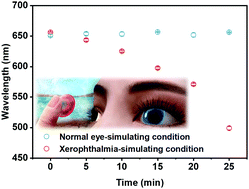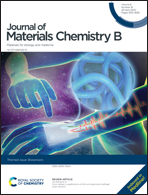Structurally coloured contact lens sensor for point-of-care ophthalmic health monitoring†
Abstract
Point-of-care (POC) diagnosis is of great significance in offering precise and personalized treatment for patients with eye diseases. Contact lenses, as a kind of popular wearable device on the eye, provide a suitable platform for the integration of biosensors for the POC diagnosis of eye diseases. However, existing contact lens sensors usually involve complex electronics and circuits, the manufacturing of which is complicated and signal readout requires additional instruments. To realize the instrument-free detection of pathologically relevant signals of eye diseases, we successfully established a structurally coloured contact lens sensor with a tunable colour in this investigation, which can directly report changes in moisture and pressure that are critical signs for xerophthalmia and glaucoma diagnosis, respectively, by altering colours. Importantly, this structurally coloured contact lens sensor is made solely from a biocompatible hydrogel, without the addition of any chemical pigments, therefore exhibiting superior biosafety and wearing comfort for wearable applications. With both excellent biocompatibility and sensing capabilities, this structurally coloured contact lens sensors thus holds great promise for instrument-free ophthalmic health monitoring, which will benefit a large proportion of the population that have a high risk of eye disease.

- This article is part of the themed collection: Biosensors


 Please wait while we load your content...
Please wait while we load your content...